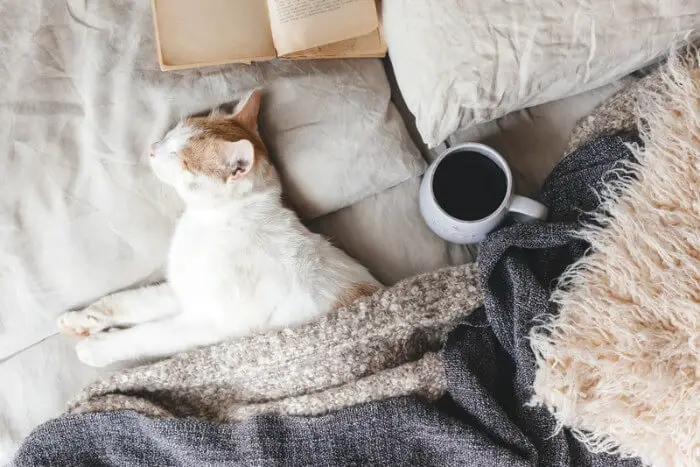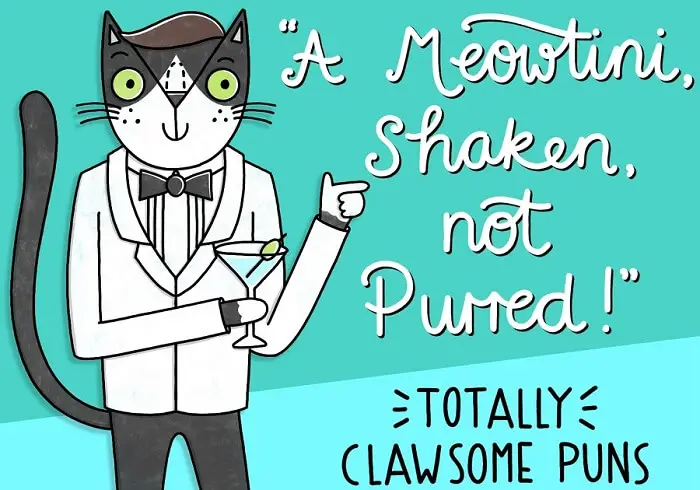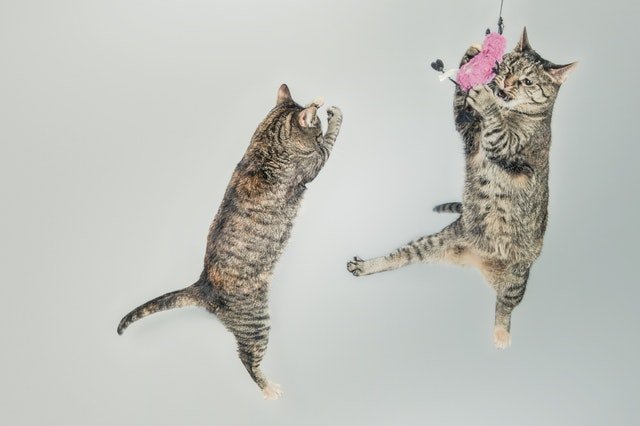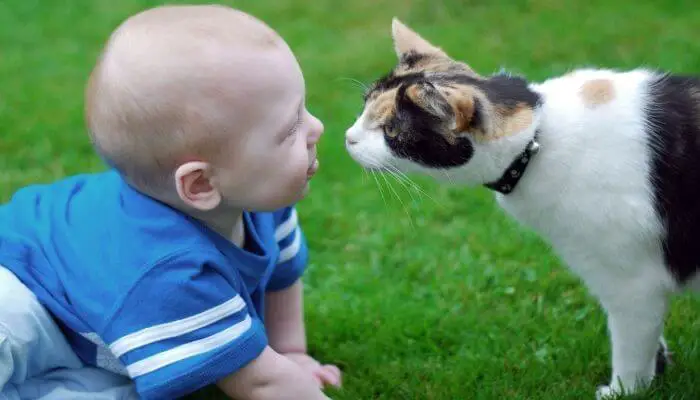Anyone who has owned a cat for any period of time will sooner or later ask the question why do cats eat grass?
This behaviour may seem strange for a carnivorous creature however cats eat grass because the fibres help your cat digest it’s food more efficiently which can help them deal with both hairballs and constipation. It also has nutrients and vitamins in it which may be missing in your cat’s diet, some cats even eat it simply because it tastes good to them!
It is normal feline behaviour so you don’t need to worry about it.
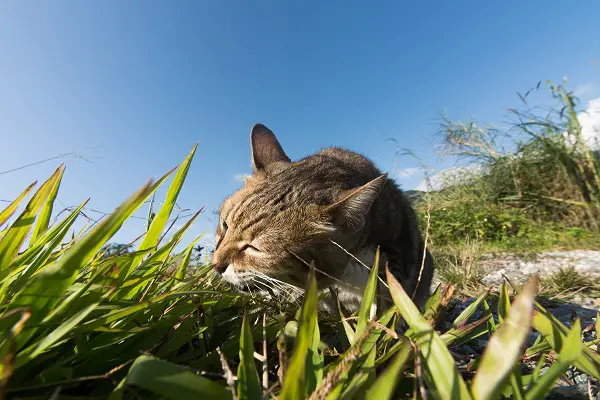
Contents
1. It Helps Your Cat’s Digestion
If your cat is having digestion problems they may eat grass to help their stomach digest their food more efficiently. It can help in a number of ways:
It Helps Your Cat Throw Up Hairballs
It is emetic, this means that it can be used to cause vomiting because of its high levels of fibre.
Your cat may choose to eat grass if they have a particularly troublesome hairball which they are struggling to get rid of.
Throwing up may not look nice but it can actually be good for your cat as it helps clear their stomach of things like hair, parasites, bones, dirt and other foreign bodies that shouldn’t be there.
Getting rid of these helps your cat to digest their food much more efficiently.
It Helps With Constipation
Cats can suffer from constipation if they are experiencing stress or if their diet is poor. Grass is natures laxative so will help your cat get unblocked…encouraging your cat to drink more water will also help with constipation too.
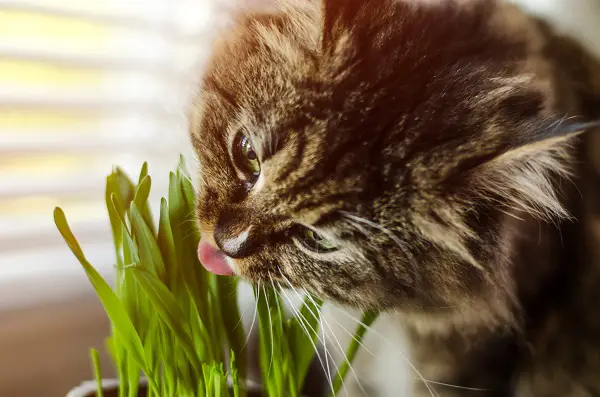
2. Cats Eat Grass Because It Is Full Of Great Nutrients
Your lawn can have some great health benefits for cats providing it has not been treated or contaminated with anything.
Cat grass is a better alternative to eating lawn as it will be contaminant free and is grown specifically for feline consumption.
It is also filled with vitamins and minerals which have plenty of health benefits.
Cat grass contains all of the following highly beneficial vitamins:
- Folic Acid: Folic acid is great for your cat’s health as it helps increase blood oxygen levels.
- Vitamin A: This helps with growth, muscle maintenance and maintaining your cat’s ability to see well in the dark.
- Vitamin B: These vitamins help in maintaining a healthy and fully functional nervous system.
- Vitamin C: Vitamin C helps your cat absorb vital minerals and also helps ensure that their immune systems stay healthy and functional.
- Vitamin K: Is important for good liver function and also help minimise the risk of blood clots forming in your cat.
- Vitamin E: Helps boost your cat’s immune system and is also great for their coat and skin.
- Chlorophyll: This is the pigment that gives grass its colour, it is useful in the healing process for your cat and also helps with bad breath too!
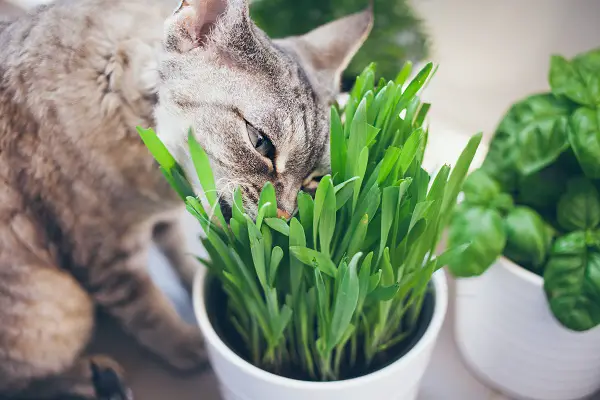
3. They Like The Taste
It sounds almost too simple but some cats will eat grass because they genuinely enjoy the taste and texture of it.
Eating grass isn’t necessarily a sign that your cat has a nutritional deficiency or is trying to move a stubborn hairball it may simply mean that your cat likes the flavour of it.
4. Grass Helps your Cat To Vomit
If your cat is eating grass but not it’s own food it maybe because it is struggling with a bad hairball or constipation.
The extra fibre stimulates the pharyngeal reflex (responsible for gagging) which can cause them to vomit thereby helping to dislodge dislodging foreign bodies from their stomach including things such as hairballs, bone and any potentially harmful germs or other pieces of rubbish that they may have inadvertently swallowed.
The fibre will also help solidify their stools.
One thing that it is important to be aware of is that if your lawn has been treated with pesticides then this can potentially be harmful to your cat, so if your cat does enjoy eating grass from your lawn then you should avoid using pesticides.

A Safer Alternative to Lawn: Cat Grass
A better, safer and more nutritious alternative to lawn grass is specially grown cat grass.
Cat grass is grown specifically for cats to eat.
The Latin name for it is Avena Sativa which is the common oat, the type you can make porridge from. However, although this is the preferred type for cats it is not the only type of grass which is suitable.
Flax, Barley and Wheatgrass are also often referred to as cat grass, as is catnip however catnip is not a grass.
How Much Grass Is It Normal For A Cat To Eat?
There is no research to suggest that eating a given amount of grass is bad for your cat. Cats will eat until they have had enough or need to throw up to clear out their digestive system.
Cats are quite good at regulating how much grass they eat so you need not worry about this. The main thing is to make sure that whatever they do eat is free from pesticides and contaminants as this can cause health problems.
How To Grow Your Own Cat Grass:
It is well worth ensuring that you have cat grass available for your cats to eat, failure to provide cat grass will mean that your houseplants will definitely suffer or your cats will resort to eating plants outside which may have been treated with pesticides which could make them very ill.
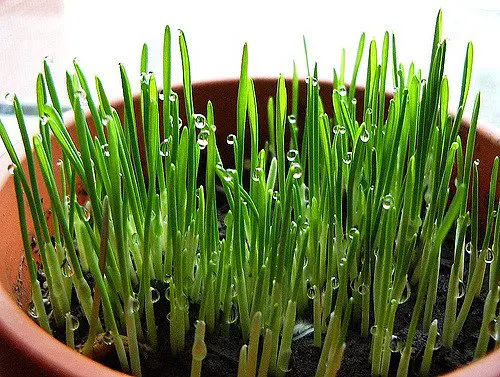
Fortunately cat grass is very easy to grow, all you need to grow cat grass is:
- a small bowl
- some compost or soil
- Seeds
- a plastic wrap
- some water
Once you have gathered everything you need then follow these five simple steps:
- Fill the bowl half full with soil and add the seeds on top.
- Cover the seeds with another layer of soil about 5mm deep.
- Water the seeds so that the soil feels nicely moist but not sodden.
- Cover the bowl with the plastic wrap and leave it in a warm dry place.
- Remove the plastic wrap in a couple of days when the grass grows through, it should take about no more than one week of growth until the it is ready for your cats to enjoy.
How Long Does Cat Grass Take To Grow?
You should start to see grass shoots a couple of days after planting and watering your seeds, these should then grow quite quickly and within 7 – 14 days (depending on the seed and how favourable the growing conditions are) they should reach their full optimal height of around four inches. At this stage it is now ready for your cat to eat it.
How Long Should Cat Grass Live For?
Cat grass has quite a short life-cycle and will usually die within 10 – 21 days.
With a bit of luck it may survive a full month however when it does discolour and start to wilt you should throw it out and plant some new seeds.
To extend the life of your cat grass for as long as possible keep it in a place where it is exposed to as much natural sunlight as possible and water it regularly.
It is important to make sure you don’t over-water it though, using a spray bottle is a good way of replicating the dew that would feed them in the wild and will prevent overwatering.
As an Amazon Associate I may earn a small fee from qualifying purchases at no extra cost to you. This helps us run the site, so thanks for your support!

